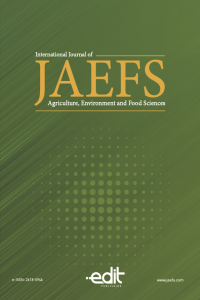Investigation of antimicrobial properties and chemical composition of different extracts of Sweet gum leaves (Liquidambar orientalis)
antimicrobial activity, extract, Sweet gum Chemical Composition, Leaves,
___
- Adams, R.P. (1995). Identification of essential oil components by gas chromatography/masss spectrometry. Allured Publishing:CarolStream,ILRetrivedfromhttps://www.scirp.org/(S(i43dyn45teexjx455qlt3d2q))/reference/ReferencesPapers.aspx?ReferenceID=394487
- Ali, N.A., W.D. Juelich, C. Kusnick and U. Lindequist (2001). Screening of Yemeni medicinal plants for antibacterial and cytotoxic activities. Journal of. Ethnopharmacology., 74, 173-179. Doi: 10.1016/s0378-8741(00)00364-0
- Basim, E. and H. Basim (2013). Antibacterial activity of Turkish endemic sweet gum (Liquidambar orientalis Mill. var. orientalis) storax against agricultural plant pathogenic bacteria and its use as a seed protectant. Journal of Food, Agriculture and Environment, Vol. 11, 2447-2450. . Retrived from[Google Scholar]
- Beatty, G.E., J. Provan (2010). Refugial persistence and postglacial recolonization of North America by the cold tolerant herbaceous plant Orthilia secunda. Molecular Ecology, 19, 5009-502. Retrived from [Google Scholar]
- Bradshaw, L.J. (1992). Laboratory microbiology. 4th Edn., Saunders College Publishing. Fort worth
- Fernandez, X., L. Lizzani-Cuvelier., A.M. Loiseau., C. Perichet., C. Delbecque., J.F. Arnaudo: (2005). Chemical composition of the essential oils from Turkish and Honduras styrax. Flavour and Fragrance Journal., 20, 70–73. Doi:10.1002/ffj.1370
- Gottlieb, O.R., Borin, M.R., de Brito, NR: (2002). Integration of ethnobotany and phytochemistry. dream or reality? Phytochemistry, 60,145-152. Doi: 10.1016/s0031-9422(02)00088-2.
- Ha¨nsel, R., Haas, H. (1984). Therapie mit Phytopharmaka; Springer: Berlin, Germany Retrived from[Google Scholar]
- Jananie, R.K., V. Priya., K, Vijayalakshmia: (2011). Determination of bioactive components of Cynodon dactylon by GC-MS Analysis. New York Science Journal, 4(4), 16-20. Retrived from[Google Scholar]
- Keskin, D., S. Toroglu: (2011). Studies on antimicrobial activities of solvent extracts of different commercial spices. Journal of .Environmental. Biology, 32, 251-256. Retrived from https://pubmed.ncbi.nlm.nih.gov/21882663/
- Kim, J. and Seo, S.M: (2008). Nematicidal activity of plant essential oils and components from coriander (Coriandrum sativum), oriental sweetgum (Liquidambar orientalis), and valerian (Valeriana wallichii) essential oils against pine wood nematode (Bursaphelenchus xylophilus). Journal of Agriculture and. Food Chemistry, 56, 7316–7320. Doi: 10.1021/jf800780f
- Kim, K.J., H.H. Yu., J.D. Cha., S.. Seo., N.Y. Choi., Y.O. You: (2005). Antibacterial activity of Curcuma longa L. against methicillin-resistant Staphylococcus aureus. Phytotheraphy Research, 19,599-604. DOI: 10.1002/ptr.1660
- Lee, Y.S., J. Kim., S.C. Shin., S.G. Lee., I.K. Park: (2008). Antifungal activity of Myrtaceae essential oils and their components against three phytopathogenic fungi. Flavour Fragrance. Journal., 23, 23–28. Doi: https://doi.org/10.1002/ffj.1850.
- Narod, F.B., A. Gurib-Fakim., A.H. Subratty: (2004). Biological investigations into Antidesma madagascariense Lam.(Euphorbiaceae), Faujasiopsis flexuosa (Lam.) C. Jeffery (Asteraceae), Toddalia asiatica (L.) Lam. and Vepris lanceolata (Lam.) G. Don (Rutaceae). Journal of Cellular and Molecular Biology; 3, 15-21. Retrived from[Google Scholar]
- Naz, S., S. Ahmad., S. Ajaz Rasool., S. Asad Sayeed., R: (2006). Siddiqi: Antibacterial activity directed isolation of compounds from Onosma hispidum. Microbiology Research. 161, 43–48. Doi: 10.1016/j.micres.2005.05.001
- Okmen, G., O.Turkcan., G. Gork: (2014). The antimicrobial activity of Liquidambar orientalis Mill against food pathogens and antioxidant capacity of leaf extracts.African Journal of Traditional, Complementary and Alternative Medicines 11, 200. Doi: 10.4314/ajtcam.v11i5.4.
- Oskay, M., D. Oskay., and F. Kalyoncu: (2009). Activity of some plant extracts against multi-drug resistant human pathogens. Iranian Journal of Pharmaceutical Research 8, 293-300. DOİ:10.22037/IJPR.2010.825
- Oskay, M and D. Sari (2007). Antimicrobial screening of some Turkish medicinal plants. Pharmaceutical Biology, 45, 176–181.Doi: https://doi.org/10.1080/13880200701213047
- Ozturk, M., A.Celik., A.Guvensen., A.E. Hamzaoglu. (2008). Ecology of tertiary relict endemic Liquidambar orientalis Mill. Forests. Forest. Ecology and. Management, 256, 510-518.Doi: 10.1016/j.foreco.2008.01.027.
- Park, I.K., and S.C. Shin: (2005). Fumigant activity of plant essential oils and components from garlic (Allium sativum) and clove bud (Eugenia caryophyllata) oils against the Japanese termite (Reticulitermes speratus Kolbe). Journal of Agricultural and Food Chemistry., 53,4388–4392. Doi: 10.1021/jf050393r.
- Park, I.K., J.Y. Park., K.H. Kim., K.S. Choi., I.H. Choi., C.S. Kim., S.C. Shin: (2005). Nematicidal activity of plant essential oils and components from garlic (Allium sativum) and cinnamon (Cinnamomum verum) oils against the pine wood nematode (Bursaphelenchus xylophilus). Nematology, 7,767–774. Doi:10.1163/156854105775142946.
- Rojas, R., B. Bustamante and J. Bauer: (2003). Antimicrobial activity of selected Peruvian medicinal plants. Journal of Ethnopharmacology, 88, 199-204. Doi: 10.1016/s0378-8741(03)00212-5
- Sagdıc, O., G. Ozkan., M. Ozcan., S. Ozcelik: (2005). A study on inhibitory effects of Sweet gum Tree (Liquidambar orientalis Mill. var. orientalis) storax against several bacteria. Phytotheraphy. Research. 19, 549–551. Doi: 10.1002/ptr.1654.
- Sarac ,N., B.Sen: (2014). Antioxidant, mutagenic, antimutagenic activities, and phenolic compounds of Liquidambar orientalis Mill. var. orientalis. Industrial Crops and Products, 53, 60– 64. Doi:https://doi.org/10.1016/j.indcrop.2013.12.015
- Schmickl, R., M.H. Jorgensen., A.K. Brysting., M.A. Koch: (2010). The evolutionary history of the Arabidobsis lyrata complex: a hybrid in the amphi-Beringian area closes a large distribution gap and builds up a genetic barrier. BMCEvolutionaryBiology,10,98. .Retrived from https://bmcecolevol.biomedcentral.com/articles/10.1186/1471-2148-10-98#citeas
- Sova. M: (2012). Antioxidant and antimicrobial activities of cinnamic acid derivatives. Mini Reviews in Medicinal Chemistry.12, 749-67. Doi: 10.2174/138955712801264792 Topal, U., M. Sasaki., M. Goto., S.Otles: (2008). Chemical compositions and antioxidant properties of essential oils from nine species of Turkish plants obtained by supercritical carbon dioxide extraction and steam distillation. International Journal of Food Science and Nutrition, 59, 619-634. Doi: 10.1080/09637480701553816
- Yasmin, H., A. Kaisar., M.R. Sarker., M.S.M. Rahman and M.A. Rashid: (2009). Preliminary anti-bacterial activity of some indigenous plants of Bangladesh. Dhaka University Journal of Pharmaceutical Sciences.8, 61-65 Doi: https://doi.org/10.3329/dujps.v8i1.5337
- Yayın Aralığı: Yılda 4 Sayı
- Başlangıç: 2017
- Yayıncı: Gültekin ÖZDEMİR
Orhan KURT, Merve GÖRE, Kübra KIR
Mehmet Zeki KOÇAK, Bünyamin YILDIRIM
Rouhollah NASİRZADEHDİZAJİ, Dilek Eren AKYÜZ
Abdullah ULAŞ, Yusuf Cem YÜCEL, Firdes ULAŞ
Tuğba İDUĞ, Hilal HIZLI GÜLDEMİR, Ali ŞEN, Osman GÜLDEMİR
Rohat GÜLTEKİN, Ceren GÖRGİŞEN, Gonca KARACA BİLGEN, Pınar BAHÇECİ ALSAN, Tuğba YETER
Öner ÇETİN, Cuma AKINCI, Önder ALBAYRAK, Muhittin Murat TURGUT, Remzi ÖZKAN, H. Kıvanç DOĞANAY
